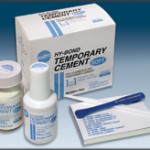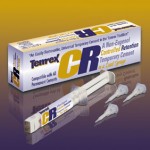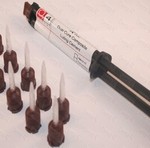Dental implants involve one or more artificial teeth being inserted into the jaw to fill a gap in the bite. Dental implants can be used to fill spaces where one or two teeth are missing, or to serve as an anchor for crowns, bridges and dentures where many or all of the teeth need to be replaced. Both temporary and permanent cement play a role in dental implants.
Function of Cement
Both temporary cement and permanent cement are used to adhere external objects, such as dental implant teeth, caps, bridges or dentures, to the natural teeth. For bridges and dentures, an anchor tooth may be chosen for the adhesive so that patients do not need to have all of their teeth cemented. Dental implants are not usually cemented to the natural teeth, and instead are actually drilled into the jawbone to become a permanent part of the jaw.
Time Frame
Dentists and periodontists may elect to use temporary cement to fix dental implants in place for a few days to allow patients to experience use of the new tooth before it is permanently in place. The initial use of temporary cement allows the dentist to make adjustments to the implant itself or to its position before permanently inserting the prosthetic.
Features
Temporary cement can be used to hold dental implants in place for anywhere from a few hours to several weeks if necessary. Permanent cement can be used to fix dental implants, particularly crowns, veneers and bridges, into the mouth. Permanent cement only needs to be put on dental implants once, and the procedure is conducted by a dentist in the office rather than by the patient at home. Permanent cement can sometimes wear down over time, allowing dental implants to loosen or detach and may need to be replaced.
Dental Implant Cement and Diving
Just because your surgeon and dentist has allowed you to wear an implant supported device sooner, it would probably NOT be wise to apply the additional biting load of a scuba regulator to the healing implants and the overlying temporary device. Micro-movement may occur and any temporary devices used which will usually be made of plastic and anchored with some sort of temporary cement or temporary screw. It would be safer to be more conservative and delay scuba diving until the final restorations are in place.
Once dental implants are fully osseointegrated and the final prostheses have been placed, there is nothing inherent to scuba diving that would pose a threat to either the implants or the restorations.
Also, some implant-supported devices are cemented and as such, a cementation failure due to pressure changes is possible. This is a rare occurrence. Some dentists prefer to use a weaker, temporary cement under the final, permanent implant crowns and bridges. This allows for future removal of the restoration if deemed necessary. Other dentists treat the cementation to implants just like teeth and use permanent cement. Their philosophy is, “If I wasn’t worried about permanent cement for teeth, why worry about it for implants?â€
It would be wise to know whether your dentist has used temporary or permanent cement under your implant restorations. The likelihood of even the temporarily cemented prosthesis coming off is rare but you should be aware that it could become a problem.
Things to be Careful about when using Temporary Cement
Because temporary dental crowns are just that—a temporary fix with temporary cement until a permanent crown is ready, most dentists suggest that a few precautions be taken with your temporary crown. These include:
- Avoid sticky, chewy foods (for example, chewing gum, caramel), which have the potential of grabbing and pulling off the crown.
- Minimize use of the side of your mouth with the temporary crown. Shift the bulk of your chewing to the other side of your mouth.
- Avoid chewing hard foods (such as raw vegetables), which could dislodge or break the crown.
- Slide flossing material out-rather than lifting out-when cleaning your teeth. Lifting the floss out, as you normally would, might pull off the temporary crown.
Benefits
Permanent cement can be used to fashion dental implants or partial implants onto natural teeth that are chipped or broken, making permanent cement a flexible tool for dentists to have at their disposal. Temporary cement is also a handy dental care tool for patients, and can also be used to replace permanent dental implants that have fallen out for any reason, until the patient is able to make an appointment to have the implant replaced professionally. Furthermore, cementation of implant restorations is able to eliminates unesthetic screw access holes. Cemented restorations also have the potential to compensate for any minor dimensional discrepancies in the fit of restorations to abutments, which can contribute to lack of passivity (Hebel and Gajjar 1997, Guichet 1994). Minor dimensional discrepancies may be compensated for by using cement and cement space.


